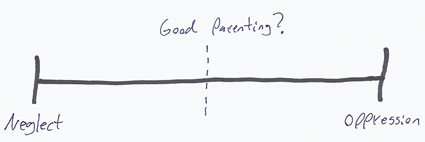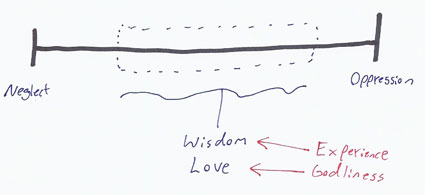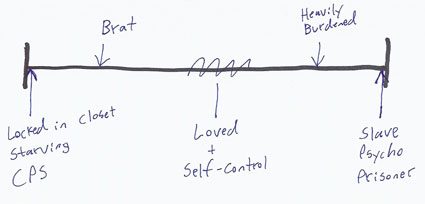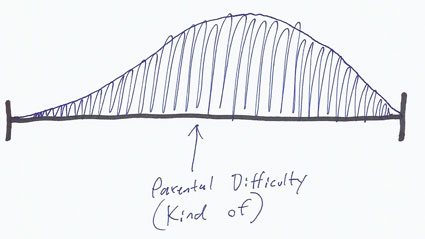This is a transcription of something I scribbled in my notebook a few days ago. It is a partially-worked-out in-progress piece of my philosophy of parenting.
The question:
What is the difference between training your children to walk on the right path and laying an oppressive burden on them?
Can you model this on some sort of continuum?

Hmmm, really? That doesn’t seem quite right. Too simple.
Let’s try again.

Alright. This is much better. At any particular moment, depending on the child, depending on the situation, it may look as if you are letting them do whatever they want or even ignoring them. Or, it could look as if you really have them under your thumb and are constraining or even disciplining them strongly. But the reality floats all along this line and changes with the context. You can get this backwards (and of course even the best parents sometimes do), but this is where good parenting lives.
How do you know where on the line to act? Wisdom and love. Wisdom comes primarily from time and experience, but having a good model to learn from (hopefully your own parents, if possible!) can be a great jump-start, even if you are only imitating their contextual actions without fully understanding why. Love is the unconditional love of God. This comes from God alone. It accompanies spiritual growth and most often looks like some form of denying selfishness.
Next, how about we place a few parenting styles on this line:

Liberal parenting (little to no discipline) lives to the left of center. Hippie/Rainbow variations are farther left.
“Christian” or “Conservative” parenting is going to live to the right. Shown are typical James Dobson-style parenting (popular in 1980-2000 American evangelicalism) and further right would be more old-school Puritan ideas. The “Tiger Chinese Mother” that caused such a stir recently in the Wall Street Journal would live even further to the right.
Now what do the kids actually look like?

On the one side we have total neglect. This is really bad. Kids starving and maybe carried away by Child Protective Services while their parents are strung out on the couch high on dope. (Please note that the fact that liberal parenting and neglect are close to each other on this line doesn’t mean that they look anything like each other. Sometimes just the opposite (see last diagram). Things are complicated. This is only one line and a first draft.)
On the farthest right, we have child as slave. Abused or extremely restricted. Likely unable to leave the house, even in adulthood. This is what some imagine Puritan children to look like (they don’t). When you read about tribal honor-killings in the news, it sure seems that maybe SOME Muslim cultures treat their daughters in a way that is close to this.
The spoiled brat is there in the middle-left. It is rare that anyone truly says “no” to him or her. On the other side, we have the child with the heavy burden. He/she does not hear “yes” very often. They are forced to conform in a thousand different ways.
Somewhere floating around the middle (again, depending on the child for more precision) will be a child who feels loved but who also has well-developed self-control.
How about one more?

This last one is kind of tricky. This is how much thought and emotional energy needs to be expended to pull it off.
Obviously the completely neglectful parent expends nothing. Oddly enough though, the very oppressive parent also doesn’t have to think much. They follow a draconian set of rules and simply execute it. That takes virtually no emotional energy or creative thought at all.
My wife pointed out that she thought the difficulty should peak over on the middle-left. That is, if you ever observe how much parents who never discipline have to expend SO much energy fighting with their bratty kids, it will sure seem as if they are running around the most. That is true. On the other hand, you may think a hovering and controlling parent (on the far-middle right) is obviously pouring tons of time and energy into their parenting. This is also true. That is why this graph doesn’t work very well. I guess I am graphing the amount of creative energy and emotional stability required of the parent to live in the wise middle zone. Nobody can do it of course, but an old and wise parent will probably be somewhere around here more often than not.
Us young parents, on the other hand, can just keep trying every day, sometimes getting it right and sometimes missing the mark badly. Let us be patient and wait for experience, and let us pray for Godliness! Then we may have both wisdom and love.
